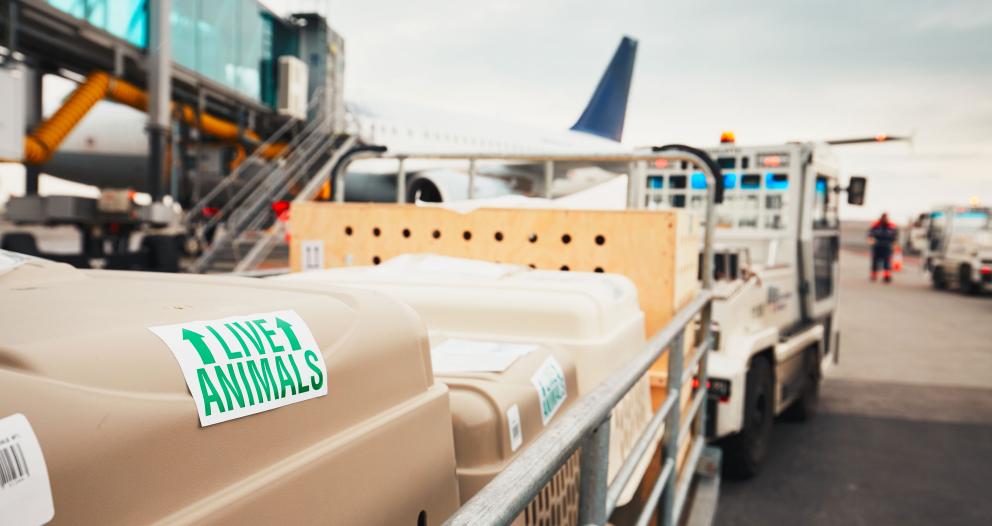You are here
Importation of Companion Animals: a Health and Welfare Perspective

A large but unquantified number of companion animals, particularly dogs, are imported into Canada each year. The source and destinations of these animals vary. Many are acquired by animal rescue organizations, brought back to Canada and adopted into homes. Others are raised overseas and brought into the country to sell for profit. While importation for these reasons are often well intentioned, importation poses significant health, environmental, and animal welfare risks that often aren’t considered by those who are importing animals or by those who are buying or adopting.
Threat from Disease
Some common countries of origin for imported companion animals include the United States and Mexico, where diseases such as canine brucellosis are far more common than they are in Canada. When rare or uncommon diseases are introduced and able to take hold, the potential for them to become endemic among the pet and wildlife populations exists. Canine brucellosis is just one of many threats and is a threat to human health as well. Other diseases that have the potential to be imported to Canada and establish themselves include canine heartworm, canine influenza, canine lungworm, leishmaniasis, screwworm, and tick-borne diseases.
In addition there are a number of parasites and diseases that imported animals could transmit to humans, These are particularly risky for the elderly and immune compromised. There have been reported cases of canine brucellosis from imported dogs that exposed a number of people including a high risk household in Alberta.
The problem is compounded by the fact that the number of animals imported into Canada each year is unknown; therefore, efforts to trace instances of rare and exotic canine diseases and zoonoses is, at present, virtually impossible.
Animal Welfare
Recent news of a Ukrainian Airlines cargo of more than 500 French bulldog puppies, 38 of whom perished in transit, is a stark reminder of the animal welfare implications of importation. The market for importation of purebred dogs exists because many Canadians are willing to pay high prices for them. In the case of the French bulldog puppies flown to Toronto from Kiev, it’s clear the profit motive outweighed the welfare of the animals, particularly when the surviving puppies would still garner considerable profit. While the fate of those dogs remains unclear, the details of their journey here should be instructive for anyone considering buying an imported dog.
Even when animals are being imported in an attempt to save lives through adoption programs, welfare can be compromised. Some recent stories in the media revealed scenarios where animals were transported in cramped quarters and intolerable heat, and some didn’t survive. Often these animals were already in need of medical attention before making the journey to Canada, and their improper travel conditions only added to their distress.
What you can do to ensure you don’t support these practices
When looking for a purebred or rescue animal, do your research. Look for local breeders and make sure they’re reputable and willing to provide a detailed, up-to-date medical history. With rescues, be sure to find out how and where they rescued the animal. Reputable rescue organizations will provide you with an animal’s medical history and be forthcoming about where the animal was acquired. When considering adopting a pet from a rescue or shelter, you can evaluate the organization using the Best Management Practices for Animal Shelters and Rescues in the Province of Alberta and ABVMA shelter evaluation guidelines.
If you’re personally looking to import an animal into Canada, be sure to have a veterinarian in the country of origin provide a detailed health certificate documenting tests completed, dates, and results. It is crucial to have rabies and brucella testing, along with parasitic treatment applied before entering the country. Finally, have it microchipped so that the animal and its medical history can be traced back to you. Once home, make sure the animal is quarantined from other animals and immune compromised people until it is examined by your veterinarian. While there’s still much work to be done at the regulatory level to help ensure the safe importation of animals, we can all do our part by asking the right questions of rescue organizations, shelters and humane societies ensuring the animals we welcome into our lives are a healthy and welcome addition that pose no risks to our environment, human or animal health.
